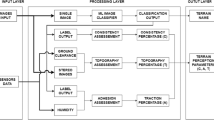Abstract
In this paper, we concern learning of terrain types based on the traversal experience observed by a hexapod walking robot. The addressed problem is motivated by the navigation of unmanned ground vehicles in long-term autonomous missions in a priory unknown environments such as extraterrestrial exploration. In such deployments, the robotic vehicle needs to learn hard to traverse terrains to improve its autonomous performance and avoid possibly dangerous areas. We propose to utilize Growing Neural Gas for terrain learning to capture the robot experience with traversing the terrain and thus learn a classifier of individual terrain types. The classifier is learned using a real time-series dataset collected by a hexapod walking robot traversing various terrain types. The learned model can be utilized to predict the traversal cost of newly observed terrains to support decisions on where to navigate next.
Access this chapter
Tax calculation will be finalised at checkout
Purchases are for personal use only
Similar content being viewed by others
References
Belter, D., Wietrzykowski, J., Skrzypczyński, P.: Employing natural terrain semantics in motion planning for a multi-legged robot. J. Intel. Rob. Syst. 93(3), 723–743 (2018). https://doi.org/10.1007/s10846-018-0865-x
Brown, D., Webster, G.: Now a stationary research platform, NASA’s mars rover spirit starts a new chapter in red planet scientific studies. NASA Press Release (2010)
Faigl, J., Čížek, P.: Adaptive locomotion control of hexapod walking robot for traversing rough terrains with position feedback only. Rob. Auton. Syst. 116, 136–147 (2019). https://doi.org/10.1016/j.robot.2019.03.008
Faigl, J., Prágr, M.: On unsupervised learning of traversal cost and terrain types identification using self-organizing maps. In: International Conference on Artificial Neural Networks (ICANN), pp. 654–668 (2019). https://doi.org/10.1007/978-3-030-30487-4_50
Faigl, J., Prágr, M.: Incremental traversability assessment learning using growing neural gas algorithm. In: Advances in Self-Organizing Maps, Learning Vector Quantization, Clustering and Data Visualization, pp. 166–176 (2020). https://doi.org/10.1007/978-3-030-19642-4_17
Fišer, D., Faigl, J., Kulich, M.: Growing neural gas efficiently. Neurocomputing 104, 72–82 (2013). https://doi.org/10.1016/j.neucom.2012.10.004
Fritzke, B.: A growing neural gas network learns topologies. In: Neural Information Processing Systems (NIPS), pp. 625–632. MIT Press (1994)
Giguere, P., Dudek, G.: Clustering sensor data for terrain identification using a windowless algorithm. In: Robotics: Science and Systems (RSS). Robotics: Science and Systems Foundation (2008). https://doi.org/10.15607/RSS.2008.IV.004
Kampouraki, A., Manis, G., Nikou, C.: Heartbeat time series classification with support vector machines. IEEE Trans. Inf. Technol. Biomed. 13(4), 512–518 (2009). https://doi.org/10.1109/TITB.2008.2003323
Keogh, E., Kasetty, S.: On the need for time series data mining benchmarks: a survey and empirical demonstration. Data Min. Knowl. Disc. 7(4), 349–371 (2003). https://doi.org/10.1023/A:1024988512476
Kohonen, T.: Self-organizing Maps. Springer, Heidelberg (2001). https://doi.org/10.1007/978-3-642-56927-2
Kottege, N., Parkinson, C., Moghadam, P., Elfes, A., Singh, S.P.N.: Energetics-informed hexapod gait transitions across terrains. In: IEEE International Conference on Robotics and Automation (ICRA), pp. 5140–5147 (2015). https://doi.org/10.1109/ICRA.2015.7139915
Kragh, M., et al.: Object detection and terrain classification in agricultural fields using 3D lidar data. ICVS 2015. LNCS, vol. 9163, pp. 188–197. Springer, Cham (2015). https://doi.org/10.1007/978-3-319-20904-3_18
Lines, J., Davis, L.M., Hills, J., Bagnall, A.: A shapelet transform for time series classification. In: International Conference on Knowledge Discovery and Data Mining (SIGKDD), pp. 289–297. ACM (2012). https://doi.org/10.1145/2339530.2339579
McGhee, R.B., Frank, A.A.: On the stability properties of quadruped creeping gaits. Math. Biosci. 3, 331–351 (1968). https://doi.org/10.1016/0025-5564(68)90090-4
Müller, M., et al.: Dynamic time warping. Information Retrieval for Music and Motion, pp. 69–84. Springer, Heidelberg (2007). https://doi.org/10.1007/978-3-540-74048-3_4
Nooralishahi, P., Seera, M., Loo, C.K.: Online semi-supervised multi-channel time series classifier based on growing neural gas. Neural Comput. Appl. 28(11), 3491–3505 (2016). https://doi.org/10.1007/s00521-016-2247-2
Prágr, M., Faigl, J.: Benchmarking incremental regressors in traversal cost assessment. In: International Conference on Artificial Neural Networks (ICANN), pp. 685–697 (2019). https://doi.org/10.1007/978-3-030-30487-4_52
Prágr, M., Čížek, P., Bayer, J., Faigl, J.: Online incremental learning of the terrain traversal cost in autonomous exploration. In: Robotics: Science and Systems (RSS), vol. 15 (2019). https://doi.org/10.15607/RSS.2019.XV.040
Prágr, M., Čížek, P., Faigl, J.: Cost of transport estimation for legged robot based on terrain features inference from aerial scan. In: IEEE/RSJ International Conference on Intelligent Robots and Systems (IROS), pp. 1745–1750. IEEE (2018). https://doi.org/10.1109/IROS.2018.8593374
Prágr, M., Čížek, P., Faigl, J.: Incremental learning of traversability cost for aerial reconnaissance support to ground units. In: Mazal, J. (ed.) MESAS 2018. LNCS, vol. 11472, pp. 412–421. Springer, Cham (2019). https://doi.org/10.1007/978-3-030-14984-0_30
Rothrock, B., Kennedy, R., Cunningham, C., Papon, J., Heverly, M., Ono, M.: SPOC: deep learning-based terrain classification for mars rover missions. In: AIAA SPACE 2016. American Institute of Aeronautics and Astronautics (2016). https://doi.org/10.2514/6.2016-5539
Shen, F., Yu, H., Sakurai, K., Hasegawa, O.: An incremental online semi-supervised active learning algorithm based on self-organizing incremental neural network. Neural Comput. Appl. 20(7), 1061–1074 (2011). https://doi.org/10.1007/s00521-010-0428-y
Stelzer, A., Hirschmüller, H., Görner, M.: Stereo-vision-based navigation of a six-legged walking robot in unknown rough terrain. Int. J. Robot. Res. 31(4), 381–402 (2012). https://doi.org/10.1177/0278364911435161
Wei, L., Keogh, E.: Semi-supervised time series classification. In: International Conference on Knowledge Discovery and Data Mining (SIGKDD), pp. 748–753. ACM (2006). https://doi.org/10.1145/1150402.1150498
Xi, X., Keogh, E., Shelton, C., Wei, L., Ratanamahatana, C.A.: Fast time series classification using numerosity reduction. In: International Conference on Machine Learning (ICML), pp. 1033–1040. ACM (2006). https://doi.org/10.1145/1143844.1143974
Zheng, Y., et al.: Time series classification using multi-channels deep convolutional neural networks. WAIM 2014. LNCS, vol. 8485, pp. 298–310. Springer, Cham (2014). https://doi.org/10.1007/978-3-319-08010-9_33
Acknowledgements
The presented work has been supported under the OP VVV funded project CZ.02.1.01/0.0/0.0/16_019/0000765 “Research Center for Informatics”. The support under grant No. SGS19/176/OHK3/3T/13 to Miloš Prágr is also gratefully acknowledged.
Author information
Authors and Affiliations
Corresponding author
Editor information
Editors and Affiliations
Rights and permissions
Copyright information
© 2020 Springer Nature Switzerland AG
About this paper
Cite this paper
Prágr, M., Faigl, J. (2020). Terrain Learning Using Time Series of Ground Unit Traversal Cost. In: Mazal, J., Fagiolini, A., Vasik, P. (eds) Modelling and Simulation for Autonomous Systems. MESAS 2019. Lecture Notes in Computer Science(), vol 11995. Springer, Cham. https://doi.org/10.1007/978-3-030-43890-6_8
Download citation
DOI: https://doi.org/10.1007/978-3-030-43890-6_8
Published:
Publisher Name: Springer, Cham
Print ISBN: 978-3-030-43889-0
Online ISBN: 978-3-030-43890-6
eBook Packages: Computer ScienceComputer Science (R0)




